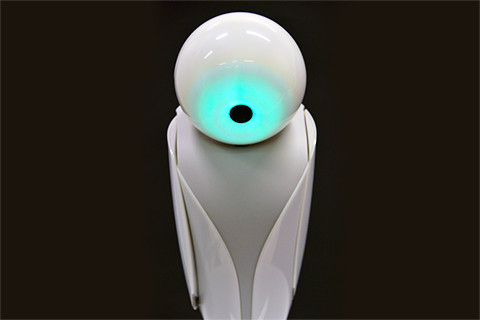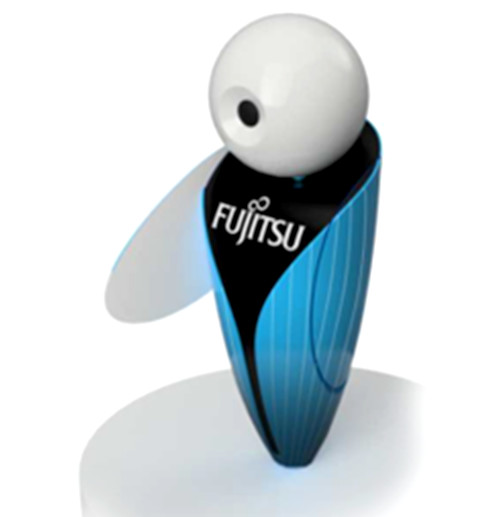Archived content
NOTE: this is an archived page and the content is likely to be out of date.
Drawing closer to people combining robot technology and AI (expressing emotions)
Robots are starting to help make our lives more enjoyable and convenient in everyday situations. An example is a service using robots in business, in a hospital, where robots use gestures and speech to guide people who are having trouble with automated reception machines. What allows this to happen is the robots communication skills, in particular its use of emotional expressions.
Nods and Facial Expressions Give People a Sense of Security
There are different types of communication: verbal communication using words and nonverbal communication using gestures, body movements, voice and facial expressions.
If the purpose of communication is simply to convey information, verbal communication using words is sufficient. However, in actual communication, not only words but also facial expressions and nods help people understand each other and convey a sense of security. In other words, it is important to combine verbal and nonverbal communication in actual communication.
This is also true for the relationship between people and robots. If a robot does not move when you speak to it, you will feel uneasy, wondering, "Is this robot really listening to me?" However, if the robot shows a reaction, such as nodding its head, in response to the conversation, you are able to continue talking to the robot, feeling more at ease.
In this way, the emotional expressions of a robot play a key role in reaching out to people's emotions and conveying information. Fujitsu has realized nonverbal communication through gestures and other means required for business communication robots by utilizing knowledge and sensitivity processing technologies.
Expressing Emotions, Taking Inspiration from Animation Characters

Fujitsu's Robopin was developed as a communication robot for business use. It is a small robot that can express emotions using gestures and making its face glow in different colors. Robopin recognizes people using a camera embedded in the center of its face and speaks with voice sounds.
Gestures
Robopin's gestures to express emotions are inspired by the expressions of animation characters. Animations create lively characters by expressing emotions of pleasure, anger, sadness and joy with simple figures, facial expressions and exaggerated actions.
Robopin has only six motors, two for the head, two for the arms and two for the body, yet it can express a variety of motions to instantly convey its emotions and intentions by changing the position and movement of its joints, which imitate the movements of animation characters.
For example, Robopin can bow by deeply lowering its head, raise both arms to do a banzai pose, overly bend back like a comedian and give directions with its hands. As such, Robopin is able to explain things with gestures to intuitively convey information in an easy-to-understand manner.
Facial Expressions
The LED attached to its head displays facial expressions. It expresses emotions with colors as well as blinking and lighting patterns based on research on impressions given by colors to people. For example, the red LED represents "anger," pink represents "pleasure" or "joy," blue "sadness," and turning these colors around represents "bewilderment."
 Welcome
Welcome
 This way, please.
This way, please.
 I'm sorry.
I'm sorry.
 Wow!
Wow!
A Simple Design Without Individuality
Robopin has a simple shape, but is able to express various emotions with a variety of actions.
Based on the assumption that various companies would use Robopin in their business, it was designed not to have any special personality. Some companies may want to add colors to Robopin in accordance with their brand colors or they may want to dress it with accessories depending on the usage. Because of its simple design, no matter how it is painted or dressed, Robopin looks natural and acceptable without conveying any sense of discomfort.
Supporting Non-Japanese and Senior Citizens and Providing Services in Large Facilities
Robopin can express emotions with a variety of actions, even with its simple shape. Let's look at possible usage scenarios for Robopin.
Robopin can contribute to more efficient customer services. The need to deal with visitors to Japan in languages other than Japanese is expected to rapidly increase ahead of the Tokyo 2020 Olympic and Paralympic Games. Robopin can provide foreign language support by using cloud-linked services, such as AI and translation services. Robopin will contribute to services that provide information, while supporting Japanese employees.
 Robopin wearing the uniform of a sports team
Robopin wearing the uniform of a sports team
If Robopin is placed in a location with no information desk, it can help improve information services. When it is difficult to assign many staff members to a large facility, such as a shopping center, compact Robopin robots can be positioned over a wide area without disturbing people, to respond to their inquiries. Robopin can also be used as a new character or symbol for towns or companies by adding their brand colors, etc.
Robopin can also be expected to provide guidance services at reception desks in hospitals and local governments by using gestures and even engaging in small talk. This all the more relevant as our rapidly aging society approaches.
Fujitsu will continue to strive to realize a business environment and society where robots can understand, work with and collaborate with people by pursuing the research and development of robots that can express a variety of emotions.